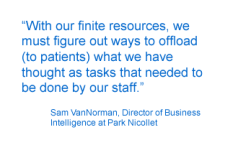A recent blog headline on the Patient-Centered Primary Care Collaborative (PCPCC) recently caught my attention. It was entitled Patient Satisfaction With Medical Home Quality High. I was intrigued. I asked myself high compared to what? Non-PCMH practices?
The study, which appeared in the November-December 2013 Annals of Family Medicine, asked 4,500 patients (2009 Health Center Patient Survey) of federally-support health centers their perceptions of a number of “patient-centered quality attributes,” including the following measures which the study authors defined as patient-centered communication:
- Clinician staff listened to you?
- Clinician staff takes enough time with you?
- Clinician staff explains what you want to know
- Nurses and MAs answered your questions?
- Nurses and MAs are friendly and helpful to you?
- Other staff is friendly and helpful to you?
- Other staff answered your questions?
Observations About The Study
The first thing that struck me was that compared to patients in the 2012 CHAPS survey (AHRQ) website, patients in the 2009 study actually reported lower levels of 1) patient satisfaction (81% versus 91%) with their clinicians’ patient-centered attributes (including communication) and 2) willingness to recommend their providers (84% versus 89%).
The second thing I was reminded of is that patients themselves are so used to clinicians’ paternalistic, physician-directed communication style that simply allowing them to ask just one question puts the clinician in the top 5% of patient-centered communicators. Stop and ask yourself when the last time was that you encountered a physician that asked you what you thought about your medical condition? Until recently I never have been and I suspect few if any people in the study cited here have either.
[pullquote]Stop and ask yourself when the last time was that you encountered a physician that asked you what you thought about your medical condition? [/pullquote]
The final thing that struck me was that none of the quality measures used in the study captured the “essential and revolutionary meaning of what it means to be patient-centered.” As Street and Epstein point out, patient centered communication is about inviting the patient to get involved in the exam room conversation.
As articulated in hundreds of studies over the years, patient-centered communication skills include:
- Soliciting the patient’s story
- Visit agenda setting
- Understanding the patient’s health perspective
- Understanding the whole patient (biomedical and psychosocial)
- Shared decision-making
- Empathy
We Need To Raise The Bar For Patient-Centered Medical Homes (PCMH)
Studies like the one cited here set the quality bar (and bragging rights) way too low for PCMH. Patient-centered care has to be different than the paternalistic, physician-directed care we all seem so willing to accept. Such studies trivialize what it means for physicians and their care teams to be patient-centered in the way they relate to and communicate with people (aka patients). Patient-centeredness is a philosophy or care…and does not require team care, extended hours or care coordinators. These are great added features, but to equate such services with patient-centeredness misses the boat…something which professional groups like the PCPCC, NCQA, Joint Commission, and URAC should recognize by now.
The Take Away?
Here’s some thoughts:
1) We need to set the bar higher for PCMHs when it comes to how we define and measure patient-centered communication.
2) We need to find better ways to asses patient-centered communications in actual practice. Patient rating of a clinician’s patiient-centeredness are simply not enough. As part of the 2014 Adopt One! Challenge, we will be using audio recording of actual physician-patient exam room conversations to measure and benchmark clinicians’ patient-centered communication skills.
3) We should stop celebrating being average whether it be in PCMH setting or hospitals when it comes to physician-patient communications.
That what I think. What’s your opinion?
Sources:
Lebrun-Harris et al. Effects of Patient-Centered Medical Home Attributes On Patient’s Perception Of Quality In Federaly-Supported Health Centers. Annals of Family Medicine. 2013; 11:6; 508-516.
Street et al. The Value and Values of Patient-Centered Care. Annals of Family Medicine. 2011; 9; 100-103.






